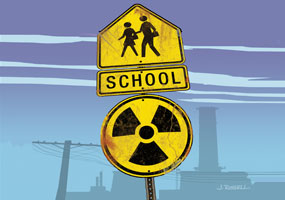Taking Precaution

Our cities are short on land and long on students in need of new schools. So it’s only natural that when city officials cast about for properties on which to site new schools, they often settle on brownfields—former factories and parcels of industrial land. But building on these sites carries worrisome potential health consequences for the students attending school there—whether through leaking chemicals, soil laced with toxins or dirty air emissions. There is little standing in the way of these projects: As the cover story in this issue explains, only a few states have environmental standards for school sites. The U.S. Environmental Protection Agency (EPA) is in the process of adopting new national guidelines, but in the meantime, kids still have to go to school.
Even rural areas have been impacted, with cleanups in several rural California districts required long after school buildings were put in place. And to the delight of Al Gore’s critics, even the new Carson-Gore Academy of Environ-mental Sciences in L.A. was built atop contaminated soil. But with an overall lack of regulation and monitoring of cleanup, there’s often little parents can do except voice their outrage. The EPA’s own revised guidelines might restrict the building of schools near Superfund sites, for example, but they are voluntary. Protecting students from harmful chemical exposures in schools may instead require much more serious oversight at the local level. In some cases, as with the Project School in Indianapolis, Indiana, a former factory—with the right level of oversight and precautions—can catalyze redevelopment and provide lessons in responsible green building.
E’s second feature this issue looks at another growing public health concern—that of zoonotic diseases, or diseases that jump from animals to humans. According to the Centers for Disease Control and Prevention (CDC), such diseases account for 75% of all emerging infectious threats. And they can start almost anywhere: from illegally imported monkeys that can spread viruses to humans or other animals or from legally imported frogs that can spread disease to local amphibians. The article looks at the tangled mess that comprises the current system of wildlife regulation, with duties spread between various federal agencies including the CDC, the Department of Agriculture and the U.S. Fish and Wildlife Service. EcoHealth Alliance is now a leading voice calling for better tracking and data collection to prevent the next SARS or monkeypox outbreak. In the meantime, agencies are left unprepared to deal with public health crises on the horizon.

